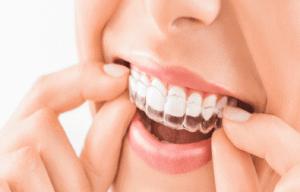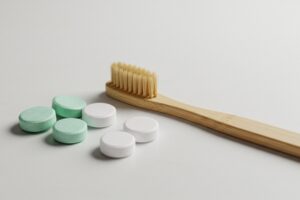What is the best pain relief for a toothache? Where can I find them?
5 min read
Toothache is a common dental problem that affects many people around the world. It is characterized by a sharp or dull pain in the tooth or the surrounding areas and can be caused by various factors, including tooth decay, gum disease, tooth trauma, or an infection.
Toothache can be a very uncomfortable and distressing experience, and it is essential to find effective pain relief to manage the symptoms.
The good news is that many pain relief options are available for toothache, ranging from over-the-counter medications to natural remedies. This article will explore some of the best pain relief options for toothache.
Over-the-counter pain relievers
One of the most common ways to manage toothache pain is to take over-the-counter pain relievers.
These medications can be easily obtained at a pharmacy or grocery store, quickly relieving toothache pain.
Some of the most effective over-the-counter pain relievers for toothache include:
1. Ibuprofen: Ibuprofen is a non-steroidal anti-inflammatory drug (NSAID) that can help reduce pain, inflammation, and fever.
It is one of the most effective pain relievers for toothache and is commonly used for tooth pain.
However, it is important to note that people allergic to aspirin should not take ibuprofen for certain medical conditions.
2. Acetaminophen: Acetaminophen is a pain reliever often used for mild to moderate toothache. It is not an anti-inflammatory drug like ibuprofen, but it can still help relieve pain and reduce fever.
3. Aspirin: Aspirin is another NSAID that can help reduce pain and inflammation associated with toothache. However, it is important to note that aspirin should not be given to children or teenagers with a fever, as it can lead to a potentially life-threatening condition called Reye’s syndrome.
It is important to follow the instructions on the medication label and not exceed the recommended dosage. If over-the-counter medications do not provide adequate pain relief, consulting a dentist or doctor is important.
Prescription pain relievers
A dentist or doctor may prescribe stronger pain medications if over-the-counter pain relievers are ineffective in managing toothache pain.
Some of the most common prescription pain relievers for toothache include:
4. Codeine: Codeine is an opioid pain medication that can be prescribed for moderate to severe toothache. It works by blocking pain signals in the brain but can also cause drowsiness, nausea, and constipation.
5. Tramadol: Tramadol is another opioid pain medication that can be prescribed for toothache. It works by blocking pain signals in the brain but can also cause drowsiness, dizziness, and constipation.
It is important to follow the instructions of the prescribing dentist or doctor and not exceed the recommended dosage.
Opioid pain medications can be addictive, and long-term use can lead to dependence and other serious side effects.
Topical pain relief
Topical pain relief products such as numbing gels or ointments can help to provide temporary relief for toothache.
These products contain local anesthetics such as benzocaine or lidocaine, which can numb the affected area and relieve pain. They are easy to apply and can be purchased over the counter at most pharmacies.
However, it is important to note that these products are only suitable for temporary relief and should not be used as a long-term solution.
They may also cause allergic reactions in some people, so reading the instructions carefully and testing the product on a small area first is important.
Clove oil
Clove oil is a natural remedy used for centuries to treat toothache pain. It contains eugenol, which has anesthetic and analgesic properties.
Eugenol works by numbing the affected area’s nerves, which helps reduce pain. To use clove oil, apply a small amount to a cotton ball and place it on the affected tooth or gums.
Saltwater rinse
A saltwater rinse is an easy and inexpensive home remedy for toothache pain relief. It works by reducing inflammation and killing bacteria in the mouth.
Ice pack
Applying an ice pack to the affected area can help reduce inflammation and numb the nerves, providing temporary pain relief.
To use an ice pack, wrap a bag of ice or a frozen gel pack in a towel and apply it to the outside of your cheek near the affected tooth for 15-20 minutes.
Garlic
Garlic has antimicrobial and anti-inflammatory properties that can help to relieve toothache pain.
To use garlic for pain relief, crush a garlic clove and mix it with a little salt to make a paste.
Apply the paste to the affected tooth or gums and leave it on for a few minutes before rinsing your mouth with warm water.
Tea tree oil
Tea tree oil has antibacterial and anti-inflammatory properties that can help to reduce pain and swelling in the mouth.
To use tea tree oil for toothache pain relief, mix a few drops with a carrier oil such as coconut oil and apply it to the affected area with a cotton ball.
Peppermint tea bags
Peppermint tea bags can relieve toothache due to their anti-inflammatory and numbing properties.
To use peppermint tea bags, place a used tea bag in the freezer for a few minutes, and then place it on the affected tooth or gums for about 20 minutes. Repeat the process several times a day.
Oregano oil
Oregano oil contains a compound called carvacrol, which has antibacterial and anti-inflammatory properties.
To use oregano oil, mix a few drops with a teaspoon of olive oil and apply the mixture to the affected area.
You can add a few drops of oregano oil to a glass of warm water and use it as a mouthwash.
Benzocaine
Benzocaine is a topical anesthetic commonly used in dental products such as toothache gels and oral sprays.
It works by numbing the nerves in the affected area, which can provide temporary pain relief.
However, benzocaine should be used cautiously as it can cause allergic reactions and may not be safe for everyone.
Hydrogen peroxide rinse
Hydrogen peroxide is a powerful antiseptic that can help kill mouth bacteria and reduce inflammation.
To make a hydrogen peroxide rinse, mix equal parts of 3% hydrogen peroxide and water and swish it around in your mouth for 30 seconds before spitting it out. Repeat this process several times a day as needed.
OTC numbing gel
Over-the-counter numbing gels such as Orajel can relieve temporary pain by numbing the affected area’s nerves.
However, these gels should be used cautiously as they can cause allergic reactions and may not be safe for everyone.
Dental treatment
While the above remedies can provide temporary relief, seeing a dentist for proper diagnosis and treatment of the underlying cause of the toothache is important.
Dental treatment may include filling a cavity, root canal treatment, or tooth extraction. Dental treatment can provide long-term relief from toothache pain and prevent further damage to your teeth and gums.
Final words
Toothaches can be very painful and can affect your quality of life. Different pain relief options are available for toothache, including over-the-counter painkillers, salt water rinse, clove oil, ice pack, and dental treatment.
It is important to consult with your healthcare provider before taking any medication or using any home remedies.
If you are experiencing toothache pain, make an appointment with your dentist as soon as possible for proper diagnosis and treatment.
Early intervention is key to preventing further damage to your teeth and gums.





